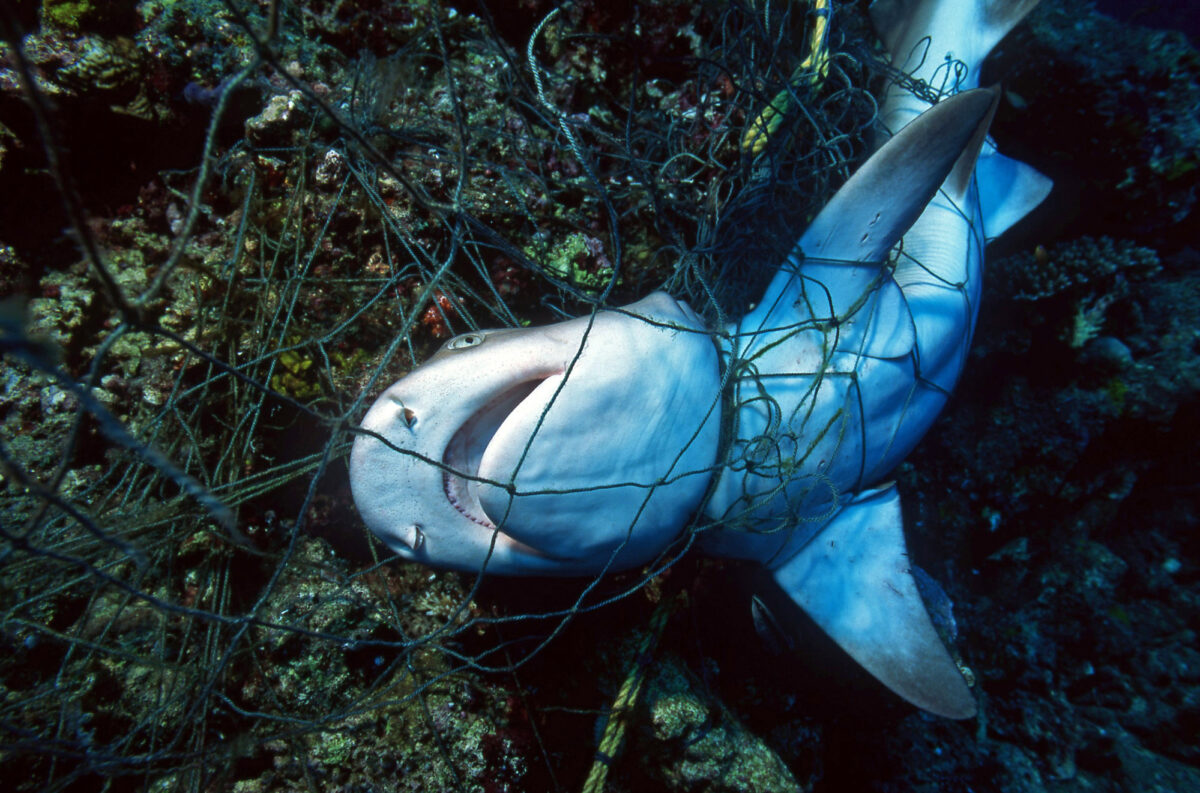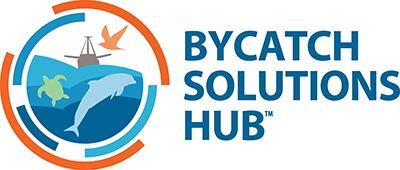Bycatch
Sharks and Rays
Bycatch in commercial fisheries is one of the greatest threats to shark and ray populations worldwide.
Since the 1970’s the global abundance of sharks and rays has declined by 71% with the primary threat the increase of fisheries throughout their range. It is estimated that 99.6% of sharks and rays are affected by fishing (primarily incidental capture). Declines were first seen in large species, which declined before the 1980’s, followed by declines in medium and then smaller species. Currently one-third of the worlds sharks, rays and chimaeras are threatened with extinction according to the IUCN Red List.
Risks for sharks and rays

Dead shark entangled in a fishing net
The full impact of bycatch on sharks is not well understood since species specific bycatch rates are not reported in many fisheries. However, it can be expected that sharks are common components of bycatch in fisheries worldwide and that mortality rates are high for many species.
The loss of sharks has been shown to negatively impact ecosystems. For example, the loss of sharks can lead to changes in the abundance of their prey species, which can lead to a cascade of other trophic-level impacts (i.e., abundance of predators can decrease, or prey behavior can be altered, thereby releasing lower-trophic-level species from predation) in the ecosystem.
It is critical to minimize the risk of bycatch on sharks in order to develop and protect healthy oceans.
Programs such as the Nature Conservancy’s Shark Bycatch Mitigation Decision Support Tool (DST) can assist to minimize the risk to sharks by identifying location-appropriate shark bycatch mitigation measures that can be enabled by electronic monitoring (EM) in all ocean areas with unsustainable shark catch.
Fishery Impacts
- Require the use of non-steel leaders and non-stainless steel hooks so that sharks can break free from the mainline and the hook will rot and fall out of the mouth.
- Require the adoption of fins naturally attached rules for fisheries that keep sharks and rays.
- Provide best methods handling and release training to the captain and crew.
- Require 100% coverage on all fishing vessels, combination of human observer and electronic monitoring, with detailed bycatch data collection.
- Ensure 100% compliance with all management measures specific to sea turtles, both at the country and management organization level.
- Prohibit setting nets around whale sharks and pelagic rays.
- Require the use of non-entangling, biodegradable FADs.
- Release sharks encircled in the net before hauling onto the deck.
- Provide best methods handling and release training to the captain and crew.
- Require trackers on deployed FADs that provide accurate and reliable geolocation and identification information.
- Require 100% coverage on all fishing vessels, combination of human observer and electronic monitoring, with detailed bycatch data collection.
- Ensure 100% compliance with all management measures specific to sea turtles, both at the country and management organization level.
- Transition to alternative gear types effective for the fishery.
- Restrict fishing in regions and times of the year with high bycatch rates.
- Limit the soak time of the gillnet to decrease time that bycatch is entangled.
- Require 100% coverage on all fishing vessels, combination of human observer and electronic monitoring, with detailed bycatch data collection.
- Ensure 100% compliance with all management measures specific to sea turtles, both at the country and management organization level.
At least one-quarter of the total catch in some pelagic longline tuna fisheries are shark species. In bluefin tuna longline fisheries, blue sharks often account for over half of everything caught. Sharks and rays are attracted to the baited hooks on longline gear and will often bite the hook. This leads to incidental capture which can secondarily lead to swallowing the hook or entanglement in the branch or main line. The species of shark typically caught depends on where the fishing is occurring and where the hooks are set.
The most commonly caught shark species in pelagic longline tuna fisheries is the blue shark. Many commonly caught species, such as mako, thresher and hammerhead sharks, are listed as Vulnerable and Endangered by the IUCN or other national measures. A major problem is the lack of data on what species and how many individuals of each species are caught in many commercial fisheries.
General Recommendations:
While less species of sharks and rays are caught in purse seine fisheries, they can lead to relatively high species-specific bycatch rates, particularly for silky and oceanic whitetip sharks. The impacts are especially high when nets are set around fish aggregating devices (FADs). Sharks are among the many species attracted to FADs and commonly caught in FAD associated sets. They also can become entangled in the webbing and netting on FADs. Therefore, it is recommended to use non-entangling FADs made of biodegradable/natural materials to prevent incidental entanglement, especially if the FAD becomes lost at sea.
General Recommendations
Sharks and rays easily become entangled in gillnets and entangling nets which lead to very high mortality rates in sharks. They are particularly vulnerable to gillnet fisheries since entanglement often prevents many species from being able to swim and pump water over their gills which leads to suffocation. There are no proven mitigation methods to decrease shark and ray bycatch in gillnets. The only way to minimize risk is through changes in fishing methods, avoiding gillnet sets in areas with large, or vulnerable shark and ray populations, or a transition to an alternative gear type. Decreasing soak time can decrease the mortality rate of entangled sharks and rays by resulting in quicker release times.
